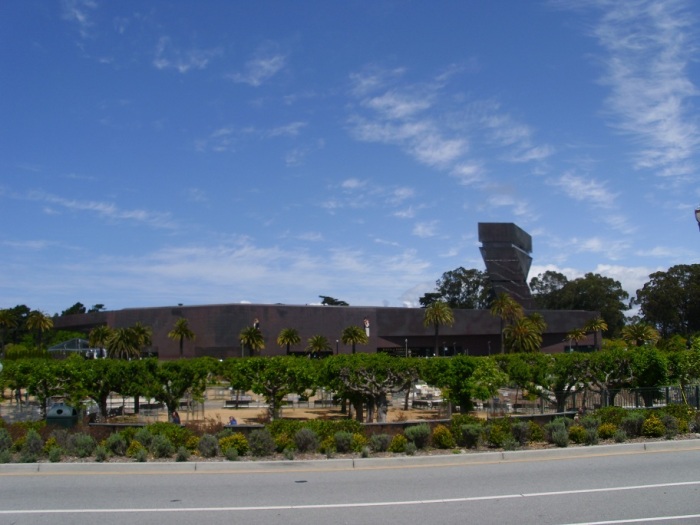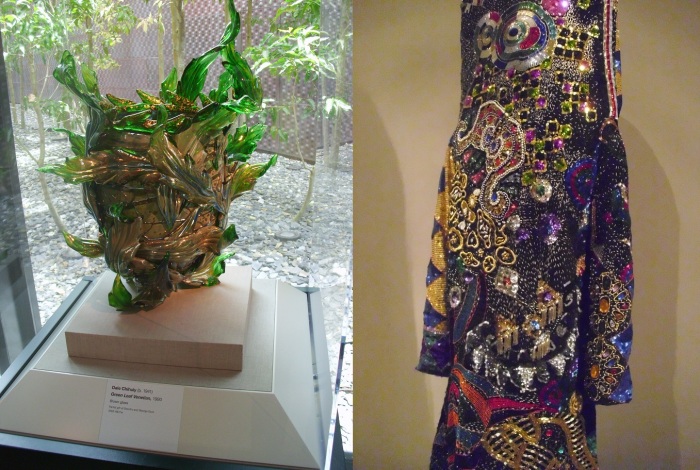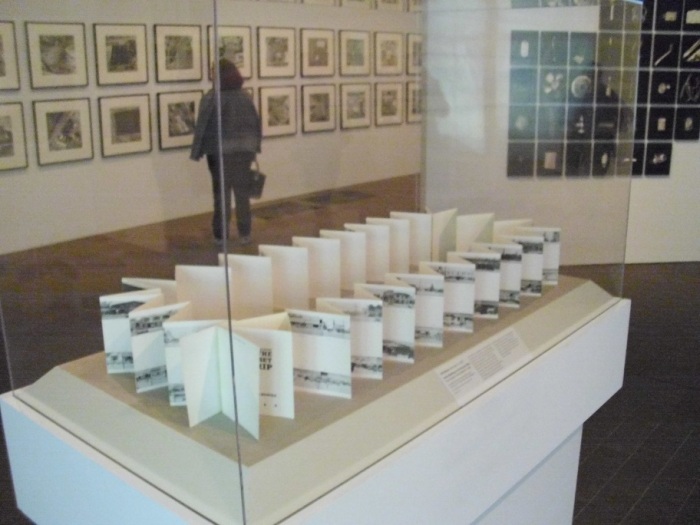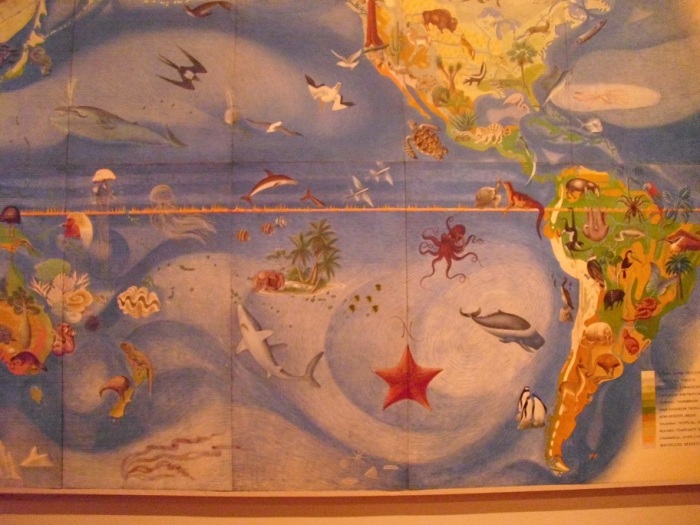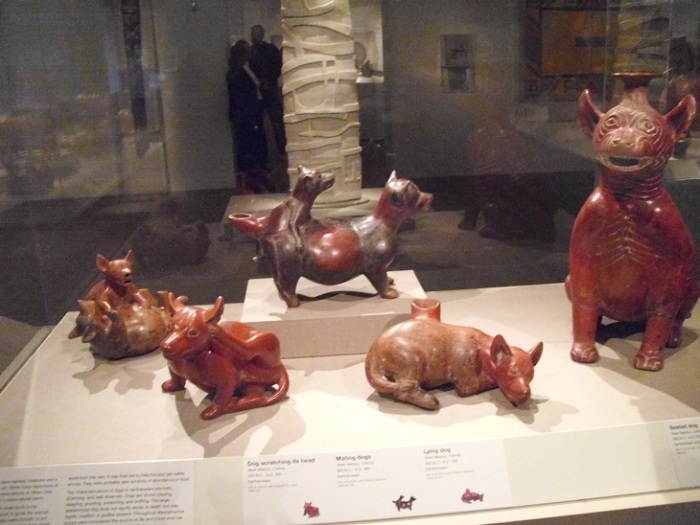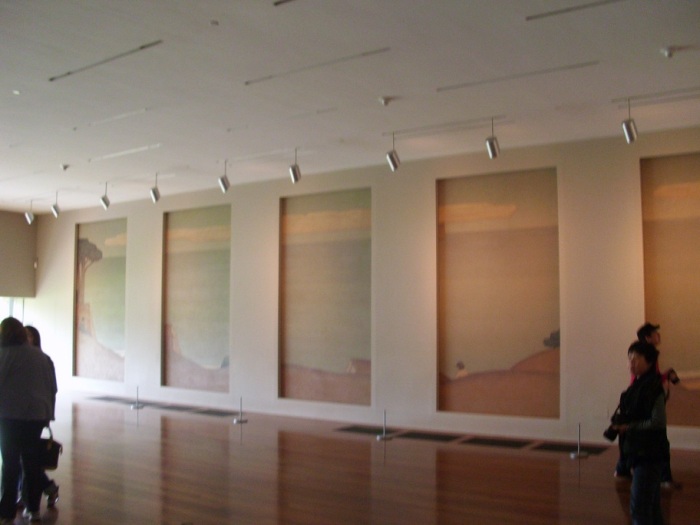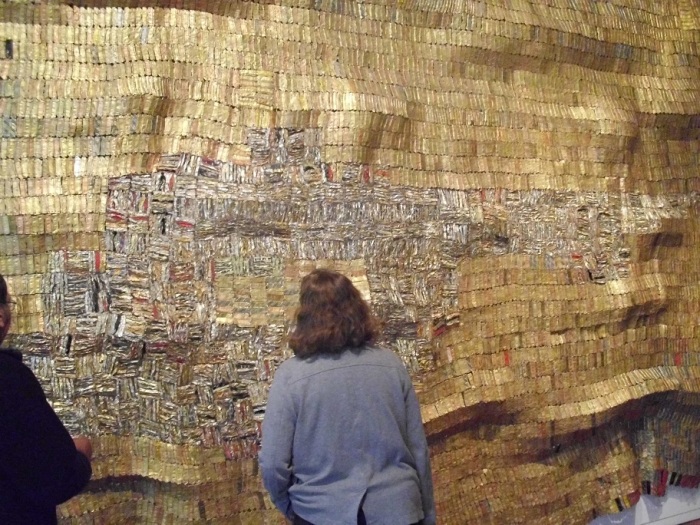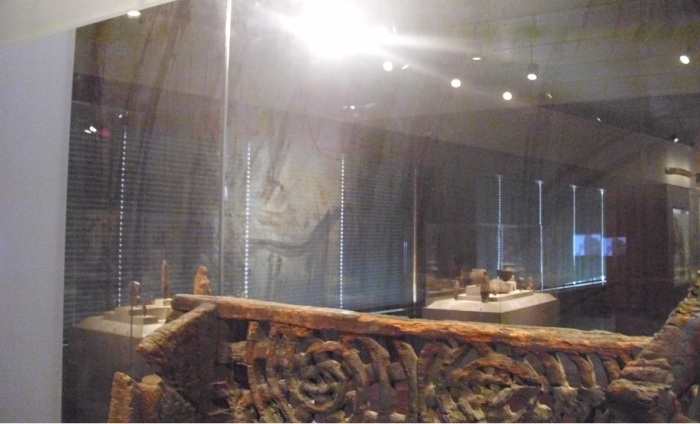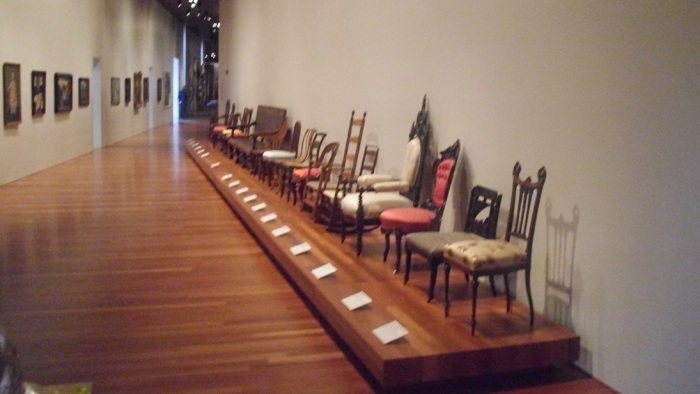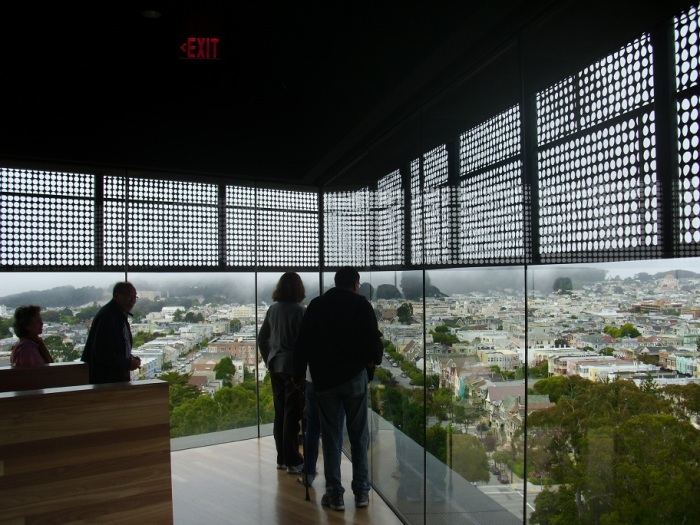Posts Tagged ‘Golden Gate Park’
Sojourn to San Francisco (Pt. 2)
de Young Museum
Across from the recently reopened California Academy of Sciences is another new building. The de Young Museum (part of the Fine Arts Museums of San Francisco) looks like a beached and rusting submarine, parked awkwardly in the middle of Golden Gate Park. Vestigial elements of the old building remain; a pair of sexy art deco sphinxes mark where the old museum’s entrance used to be (a few hundred feet from where it is now).
Several of the museum’s collections are displayed on the first floor: Alaskan art, some contemporary decorative arts, Pre-Columbian, and modern and contemporary American painting and sculpture. Alaska art (mostly small crafts pieces) leads to the contemporary decorative arts gallery. This room contains a mixture of tacky glass pieces from the 80s (purple and teal color palette dominates), predictable pieces like Chihuly, and a Nick Cave body suite thrown in. The dec arts room leads off in two directions, one to the randomly linked pre-Columbian galleries, the other way along a window-lined hallway to the modern and contemporary galleries.
These collections are given the most real estate—allowing the large sculptures and paintings space to breathe without competing with each other. For example: even though Josaih McElheny’s Model for Total Reflective Abstraction (after Buckminster Fuller & Isamu Noguchi) takes up most of the floor in one room, a hanging fixture of burn wood, Cornelia Parker’s Anti-Mass, and Al Farrow’s cathedral reliquary made from ammunition are all given their due space.
Several rooms of painting later, was a smaller room with a special curatorial title and wallpanel. Photo / Synthesis features works by eight contemporary artists “who have explored various methods of assembling and organizing photographic images into multifaceted constructions.” Predictably Ruscha is included; in a series of parking lots, and of course Every Building on the Sunset Strip. I was surprised with how awkwardly the accordion book was displayed, it was even worse than how it was displayed in LACMA’s New Topographics. The form of book was completely denied in the de Young’s display, which was laid out in a ring standing up on its side. The display of Every Building that I think was the most successful was how it was displayed in a show at the USC Fisher Museum of Art. In a long display case that reached almost from wall to wall, the accordion book was laid out flat and almost to its full length.
I circled back to explore the Pre-Columbian galleries. Pre-Columbian galleries interest me especially since seeing the Jorge Pardo designed galleries at LACMA. (Look for a post comparing LACMA’s Pre-Columbian galleries to the Natural History Museum’s galleries soon.) Had I come out of the dec art gallery into the Pre-Columbian galleries, the first thing I would have seen would have been the dominating wall mural. This kitchy map of the world displays various flora and fauna, and seems more educational in function than artistic. The de Young sometimes has an odd way of connecting adjacent galleries with seemingly unrelated works. This map is one of those odd ways.
The display of the Pre-Columbian collection is fairly standard, other than being in a glass walled, natural light-flooded room. At the de Young wall cases, and free standing glass vitrines are light naturally, somehow making the objects more relatable and utilitarian, rather than simply being elevated to the level of an art object.
Little explanation is given for many of the objects, especially in the case of the Western Mexican ceramics. These objects are notoriously looted, and became popular with collectors especially in the early half of the 20th century. One of these ceramics even features prominently into an Alfred Hitchcock film. Similar like ceramic objects are gathered into vitrines, one has a cache burnished dogs in various activities, even including copulation.
Another thing that struck me about some of the Western Mexican ceramics was the similarity of works, with ones I have seen in Los Angeles. The female and male burial pair with odd geometric appendages is almost identical to ones found in the Natural History Museum. A figured with a white running geometric design is a twin of one in the Natural History Museum, and a triplet to another at LACMA. These “types” are so prevalent in collections, and yet so little is known about them as they are scavenged from burial sites with no archeological information known about them.
Other works in the de Young’s collection do have a lot of attribution, explanation, and even respectly present this information. One dim room contains a collection of murals from Teotihuacan from the Wagner Collection. The wallpanel is almost apologetic and therefore praiseworthy for its honesty and its explanation about museum collecting practices.
“Owing to the size and importance of the donation and ethical issues regarding cultural patrimony, the museum approached officials in Mexico to discuss a cooperative program of conservation and care and the voluntary return of at least half of the murals to Mexico. After several years of negotiation, an agreement between this museum and Mexico’s National institute of Anthropology was executed, providing for the joint conservation, exhibition and disposition of the collection.”
I am really struck with the honesty of this wall panel, and think that it should be seen as an example of the correct way to handle issues of cultural patrimony, and the transparency of the museum’s wheelings and dealings. Okay, I’m getting a little choked up about the walltext…didactics aside, the murals were in excellent condition, the color looks like it was applied days ago instead of the centuries ago that it actually was.
The last thing of note on the ground floor of the museum was a tiny little annex of a room which contained two mural cycles. The two murals, The Land and The Sea, were painted by Gottardo F.P. Piazzoni between 1929 and 1932. More transparency! The labels for these works say they are a “transfer” from the S.F. Arts Commission and the Asian Art Museum. The two, five-panel murals were painted originally for the Old Main Library, and suggested views that might have been seen through the walls of the building. The murals were removed from the Beaux Arts building when it was converted into the Asian Art Museum. The room in which they are now displayed “was designed to reflect the dimensions and arrangement” of the original location. I have a soft spot in my heart for projects like these since I worked a mural cycle, which had been removed from its original home.
The second floor has galleries reserved for temporary exhibitions, as well as the display of its early American, African, and Oceanic collections. A curatorial trend I’ve noticed with the display of African art is to introduce it with contemporary works. Both in L.A. (at LACMA recently) and at the de Young this took the form of an El Anatsui work. The massive wall hangings, which look like glittering golden weavings by El Anatsui are actually made from recycled metal liquor bottle caps. The works are made in El Anatsui’s native Ghana. The contemporary work which is still craft-based is supposed to related to the more traditional African works in the galleries like masks and ceremonial objects.
Across from the El Anatsui work is the intro walltext for the African galleries. More honesty and transparency:
“The museum’s collection of African art originated in the California Midwinter Exposition of 1894, when exhibits from “the colonies of Africa” and countries around the world were displayed in pavilions in Golden Gate Park. The objects were presented as exotic curiosities in a stereotyped, even racist, manner; few people saw them as works of art.”
It then explains how the collection grew mostly randomly from various sources and that the objects on display are “mostly traditional-based arts,” but that the museum hopes that it will “grow in multitude and dimension in the future.” This declaration for pursuing an increasingly scholarly and serious collection makes the collection more valuable to the public. It also seemed to be a genuine statement of redress .
Linked to the African galleries are the Pacific Island galleries (typical museum strategy for putting the “primitive art” next to one another. The de Young never uses the term “primitive” I should add.) The large wooden vitrines are massive and beautiful in their own right except they seem in desperate need of cleaning. Finger and large handprints were strikingly visible on the glass of the cases, and they seemed neglected. This bothered me mostly because the remedy seems so easy, grad some Windex!
The de Young also has an extensive collection of earlier American art installed on the second floor: painting, sculpture, decorative arts and furniture. One of my favorite installations of objects from the permanent collection was an installation of a slew of various chairs in a skinny corridor. This installation seemed Warholian, and reminded me of Warhol’s curated show Raid the Ice Box at the Rhode Island School of Design. Unlike Warhol’s exhibition, all of the chairs in the de Young display are well conserved, but viewing them like this in one line allows for a visitor to see trends in object-making and compare materials and craftsmanship.
Crowning the museum is an observatory tower whose top floor can be accessed by the public and allows for sweeping views of Golden Gate Park, and on less-foggy days amazing unobstructed views of the city. The de Young also has special exhibition space. The largest of these exhibition spaces is on the lower level of the building. The next post will be a review of Birth of Impressionism, a traveling exhibition of works from the Musee de Orsay.
– H.I.
Sojourn to San Francisco (pt. 1)
California Academy of Sciences
Recently I took a trip north to San Francisco and of course I visited a few museums. The next few installments of Exhibition Inquisition are going to be about museums in Norcal, this is a way to gradually wean you off of Los Angeles reviews, as I will be moving to Chicago in fall. Also notice to Chicago: here I come.
I didn’t just visit art museums during my trip north, but also visited the California Academy of Sciences in Golden Gate Park. I had been to the academy numerous times as a child, but hadn’t been since the Renzo Piano renovation had opened. Of course Renzo Piano is also the architect of the BCAM at LACMA, and the soon-to-be-opened Resnick Pavilion, also at LACMA. The architectural comparisons are fairly obvious: dominant cement and glass materials punctuated with accents of firetruck red. The elevator at the Academy is of a twin of the one at LACMA. Other than the obvious the Piano’s process of acknowledging the function and purpose of the building, and allowing that to dictate the form and design of the building. Critics aside, BCAM operates as it was supposed to: a white cube for the display of contemporary art. The Resnick Pavilion will do the same: a warehouse for creating temporary spaces for temporary exhibitions. The Academy of Sciences works the same way.
The building is dominated by two large spheres (one is a planetarium, and one holds an indoor rainforest) whose forms are embraced by the roof of the building. This can be seen in the architectural sketch by Piano. The entry space is dominated by a large T-Rex skeleton. I thought it was noteworthy that even in this contemporary space that looks nothing like a traditional museum, some vestiges were left, like the dinosaur skeletons being the first thing one see as they enter.
Behind this was an open air piazza that is nestled in-between the two orbs. Around the two large spheres is water; a visitor has to go below ground level to understand that the water goes many feet below and is actually the top of several large aquarium tanks. The building is a shrine to the sciences full of specimens and takes every opportunity to educate. Literally no space is left unoccupied by something thought-provoking or beautiful.
Old favorites are still around. The biggest celebrity of the academy is the extremely rare albino alligator named Claude. I remember seeing this baby both at the original academy and at the San Francisco Zoo at one point in time. The old white guy was return to an enclosure that is fairly similar to the original. Around the top of the case is a fairly tacky railing made up of bronze sea horses. The sea horses are one of the details from the original building that were left intact. A docent of the Academy (who knew my father, because my father knows literally everyone in the Bay Area) told me that his father was the artist who created the sea horses.
Below ground level was the aquarium space, which I have to say was not my favorite. Strikingly similar to the Pardo-designed display cases in LACMA’s Pre-Columbian galleries, were some smaller sized tanks filled with various species.
Curvatious glass forms refracted the light and distorted the forms of the sea creatures within giving them a freakish fun-house mirror effect. These smaller cases were accompanied by the large tanks full of many schools of fish, which were separated into several climates and locations.
I got thirsty while on the aquarium level and was amazed to find that even the act of drinking from the water fountain had been turned into an educational experience. The Academy took this moment to inform me about the benefits of tap water versus bottled water. This was similar to the moment I had when throwing away a piece of gum, where I was greeted with information about recycling which was mounted on the various trash and recycling cans.
Back upstairs are the more traditional displays of taxidermied animals, mostly mammals from Africa. Some oldies are still goodies. I was absolutely astounded by the amount of detail that had executed in these display cases, in one scene flora surround the fauna but are given as much attention, including a beetle that seemingly meanders across a flower.
The tableaus of frozen wildlife were mixed with staggered cases of live specimens and cases displaying only skeletons. At the end of the hall was the ever popular penguin display, which gets crowded several times a day during feedings. The coffered ceiling of the mammal hall had been preserved much like the seahorse balcony. The ceiling had been livened with a coat of fresh white paint, but the arched barrel vault remained.
Outside of the mammal hall is a crowded space full of smaller displays covering an array of topics including evolution and the Galapagos Islands. One space that was getting a lot of attention from the kids was a media center that just played newsworthy pieces on several gigantic screens. The media space was set in front of an audience of mostly empty chairs; this seemed to be the place the grandparents took a quick break from the screaming masses.
Next it was time to explore the rainforest dome. This portion of the visit required waiting in line as only so many visitors are allowed in the climate controlled dome at once. I was wearing a jacket and scarf the whole day at the museum, but quickly removed them once inside the rainforest dome. Inside is a whole different world, you enter at the ground level and slowly work your way up so that you can experience the different sub-environments. Birds and butterflies perch and swoop through the air all around the dome.

Visit just for this, because really, when is the next time you’re going to be in an Ecuadorian rainforest?
Then it was time for the planetarium show, which took place inside the other dome. The curved space was all encompassing and would have been a very serious experience had the documentary movie not been narrated by Whoopi Goldberg. I have to say I did prefer Whoopi to Oprah on the Life series, but that is mostly because whenever Oprah talked about mating I got creeped out.
The visit wasn’t over until we went to the roof of the building. Yes the roof looks like the set for the teletubbies show, but it’s actually a very practical and environmentally sound usage of a roof. I can’t even begin to explain how amazing this roof is, but there is a lot to say and the Academy tells you most of the information on placards surrounding the accessible portion of roof.
All in all the new Academy of Sciences was everything I hoped it would be, so education, and yet so full of wonderful surprises. The building and its architecture makes an exclamation point to the statements within about recycling, global warming, and climate change. Even though I tried to see everything in one day, I’m sure each time I go back I will see and learn something new. Below is a slide show of additional photos, since I feel like I couldn’t explain everything in this one post.
– H.I.
P.S. How could I almost forget about the actual art installation at the Academy?! A few years back the De Young Museum, across the way from the Academy, organized a show of Maya Lin’s artworks. Linn who is most famous for the Vietnam War Memorial in Washington D.C. works in a variety of media. One of the last works in that exhibition, called Systematic Landscapes, were the preparatory sketches and designs for an artwork that was going to be installed at the Academy of Sciences once it reopened.
This work is called Where the Land Meets the Sea, and it hangs outside the Academy. The works is made up of a grid of seemingly randomly bent and twisted wires. The work actually is an exaggerated topographic map of a portion of the San Francisco Bay. Some of the high and low points have distinguishable references, like Angel Island. This artwork is simultaneously aesthetically beautiful, and would be appreciated without knowing what it represents or what inspired it, but upon further self-driven exploration is really an education tool. Job well done Academy of Sciences!
